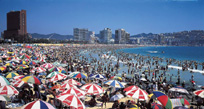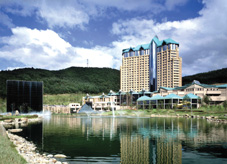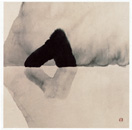Heading toward Culture &
Tourism Powerhouse
Unveils plans to nurture culture, tourism & leisure-sports as growth engines
 The government has unveiled an ambitious blueprint to build Korea as a cultural powerhouse by 2010 by fostering culture, tourism and leisure-sports as next-generation growth engines.
The government has unveiled an ambitious blueprint to build Korea as a cultural powerhouse by 2010 by fostering culture, tourism and leisure-sports as next-generation growth engines.
Minister of Culture and Tourism Chung Dong-chea reported to President Roh Moo-hyun in a session held in Yongpyong Resort on July 6 the plan, dubbed "C-KOREA 2010.The C-Korea plan, based on 3Cs - Contents, Creativity and Culture - calls for the strategic cultivation of culture, tourism and leisure-sports industries with the goal of raising the per-capital national income to $30,000 and contributing to easing regional imbalanced development and social bi-polarization. The Ministry of Culture and Tourism (MCT) considers that creativity, the source of value added and driving force behind an economic growth in the 21st century, can be nurtured through culture, and contents can serve as an essential factor in determining a competitive edge in culture, tourism and leisure-sport industries.
 In connection with the implementation of C-KOREA 2010, MCT has set three policies - developing Korea as a top five culture powerhouse,Northeast Asian tourism hub and a global top 10 leisure-sports powerhouse.
In connection with the implementation of C-KOREA 2010, MCT has set three policies - developing Korea as a top five culture powerhouse,Northeast Asian tourism hub and a global top 10 leisure-sports powerhouse.
MCT will put more energy into building up a new framework so that the private sector can promote creativity in the culture,
 tourism and leisure-sports industries. The government will perform a function of making a fair judgment to facilitate market forces, departing from its patriarchal role of the past.
tourism and leisure-sports industries. The government will perform a function of making a fair judgment to facilitate market forces, departing from its patriarchal role of the past.
The ministry's decision to encourage the private sector' investments through the BTL (Build, Transfer and Lease) and the operation of cultural industry funds is construed as its willingness to reposition its roles and support methods.
 The ministry will provide support for exploring the "Blue Ocean"- creating new global markets and demands - in the culture, tourism and leisure-sports industries, departing from the "Bed Ocean,"the existing markets with cut-throat competition among market participants.
The ministry will provide support for exploring the "Blue Ocean"- creating new global markets and demands - in the culture, tourism and leisure-sports industries, departing from the "Bed Ocean,"the existing markets with cut-throat competition among market participants.
 For instance, the ministry will implement the planned futuristic tourism-leisure city projects in the way new tourism demands and markets targeting Northeast Asia beyond the domestic boundary can be created.
For instance, the ministry will implement the planned futuristic tourism-leisure city projects in the way new tourism demands and markets targeting Northeast Asia beyond the domestic boundary can be created.
Collaboration among the business community, college, research institution and government sectors will be reinforced and relevant government agencies
 will be asked to sign an MOU on duty cooperation in a bid to facilitate governance system, thus maximizing synergy effects. A representative success story of such efforts is the Daegu Regional Cultural Industry Complex in which a specialized cultural industry cluster, including the gaming industry, has been established in college campus buildings.
will be asked to sign an MOU on duty cooperation in a bid to facilitate governance system, thus maximizing synergy effects. A representative success story of such efforts is the Daegu Regional Cultural Industry Complex in which a specialized cultural industry cluster, including the gaming industry, has been established in college campus buildings.
As part of its efforts to promote the culture industry, the
 government will overhaul investment conditions, reform the distribution channels of cultural contents, build infrastructure for facilitating the patents industry and strengthen han, Korean national's national brand by spreading the Korean cultural fade among Asian countries,known as the Korean Wave.
government will overhaul investment conditions, reform the distribution channels of cultural contents, build infrastructure for facilitating the patents industry and strengthen han, Korean national's national brand by spreading the Korean cultural fade among Asian countries,known as the Korean Wave.
In particular, the government will set up 15 Korean
 cultural promotion centers, dubbed "Korea Plazas"in Asian counties as well as Latin America and East Europe by 2015. The Korea Plazas are designed to promote Korean culture and tourism, sell Korean products, including dramas and films, and immersion of Korean culture. Korean language courses and other projects related to the han brand will be also implemented.
cultural promotion centers, dubbed "Korea Plazas"in Asian counties as well as Latin America and East Europe by 2015. The Korea Plazas are designed to promote Korean culture and tourism, sell Korean products, including dramas and films, and immersion of Korean culture. Korean language courses and other projects related to the han brand will be also implemented.
 A separate private entity will be established or if necessary Korea Center or KOTRA branch offices will be utilized.
A separate private entity will be established or if necessary Korea Center or KOTRA branch offices will be utilized.
The tentatively named Han Brand Strategy Committee, led by the prime minister, will be established to work out and implement such support strategies as the expansion of infrastructure, an overhaul of related systems and support for entering the overseas markets.
The government will build up infrastructure for industrializing
 han brands tailored to the characteristics of each region ? hansik, Korean food in South Jeolla Province, hanbok (Korean costume) in Jinju, hanji (Korean paper) in Jeonju and Wonju, hanok (traditional Korean house) in Seoul and Jeonju l and hangukhak (Korean study) in Andong.Special purpose companies, a kind of paper companies, will be introduced to ensure transparency in a flow of culture industry funds into projects and encourage investments into the culture industry.
han brands tailored to the characteristics of each region ? hansik, Korean food in South Jeolla Province, hanbok (Korean costume) in Jinju, hanji (Korean paper) in Jeonju and Wonju, hanok (traditional Korean house) in Seoul and Jeonju l and hangukhak (Korean study) in Andong.Special purpose companies, a kind of paper companies, will be introduced to ensure transparency in a flow of culture industry funds into projects and encourage investments into the culture industry.




 The government plans to expand tourism resources tailored to each region? characteristics to divert Korean tourists from overseas to domestic destinations and accept 10 million inbound foreign visitors.
The government plans to expand tourism resources tailored to each region? characteristics to divert Korean tourists from overseas to domestic destinations and accept 10 million inbound foreign visitors.
 MCT Minister Chung said his ministry is seeking to exempt the value added tax imposed on tourist hotels as part of its efforts to increase Korea's price competitiveness, lagging behind that of neighboring rival countries, with the goal of attracting 10 million inbound foreigners per annum. If tourist hotels were exempted from the value added tax, they would attract an additional
MCT Minister Chung said his ministry is seeking to exempt the value added tax imposed on tourist hotels as part of its efforts to increase Korea's price competitiveness, lagging behind that of neighboring rival countries, with the goal of attracting 10 million inbound foreigners per annum. If tourist hotels were exempted from the value added tax, they would attract an additional
90,000 inbound tourists in the 2004 levels.
MCT is seeking to revise relevant laws so as to provide the tourism industry a means of attracting foreign tourists with the same
 preferential treatment given to the export manufacturing industries.
preferential treatment given to the export manufacturing industries.
It will increase the number of tourist accommodation facilities from current 62,000 rooms to about 100,000 rooms by 2010. The ministry plans to convert motels into low-pricedand middle-level priced tourist hotels. It will strengthen marketing activities aimed at promoting Korea's tourist resources by making the most of the 2008 Beijing Olympic Games and the 2010 Shanghai Expo.
The government will encourage one county in each city of Gangwon Province to develop its own unique tourism or leisure-sport centerunder the scheme of making the province a four-season tourism and leisure-sports mecca.
As a means of promoting the development of the leisure-sports industry,
 the government will actively foster the value added sports devices industry, expand the infrastructure in the leisure-sports industry and support the self-survival of the professional sports industry.
the government will actively foster the value added sports devices industry, expand the infrastructure in the leisure-sports industry and support the self-survival of the professional sports industry.
It plans to encourage the development of the advanced sports devices industry by making the most of Korea? strength as one of the global ICT powerhouses.
The government will expand the international standard certification system, KISS, while providing financial support in R&D outlays. It will support 30 billion won for the development






 of 30 items during the 10-year period. It will seek to construct world-class baseball dome parks through overhauling the operation of pro sports organizations in a bid to meet the rise leisure-sports demand. MCT will seek to expand the participants of the existing Korea-Japan-China soccer competition, while trying to host such strategic international sports competitions as PGA's and Baseball Word Cup games. The government will actively provide support for Gangwon Province's bid to bring the 2014 Winter Olympic Games to PyeongChang and Chuncheon's bid for hosting the 2010 World Leisure Congress. A survey made by the Seoul National University Sports Industry Study Center in 2004,shows that PyeongChang's hosting the 2014 Winter Olympic Games would bring about tremendous economic benefits - 11.51 trillion won in production, 5.1 trillion won in value added on top of creation of 143,000 jobs.
of 30 items during the 10-year period. It will seek to construct world-class baseball dome parks through overhauling the operation of pro sports organizations in a bid to meet the rise leisure-sports demand. MCT will seek to expand the participants of the existing Korea-Japan-China soccer competition, while trying to host such strategic international sports competitions as PGA's and Baseball Word Cup games. The government will actively provide support for Gangwon Province's bid to bring the 2014 Winter Olympic Games to PyeongChang and Chuncheon's bid for hosting the 2010 World Leisure Congress. A survey made by the Seoul National University Sports Industry Study Center in 2004,shows that PyeongChang's hosting the 2014 Winter Olympic Games would bring about tremendous economic benefits - 11.51 trillion won in production, 5.1 trillion won in value added on top of creation of 143,000 jobs.
Chuncheon is competing with Rimini, Italy in the final bid race for hosing the 2010 World Leisure Congress. The World Leisure Congress, being held every two years, was held in Brisbane in 2004. Hangzhou, China, has been awarded the 9th 2006 World Leisure Congress, while Quebec will host the 10th World Leisure Congress in 2008.nw

Minister of Culture and Tourism Chung Dong-chea
President Roh Moo-hyun listens to a briefing on PyeongChang's bid for the 2014 Olympic Games on July 6, as Minister of Culture and Tourism Chung Dong-chea looks on.
MCT Minister Chung Dong-chea presides over the WTO Executive Council Meeting in Bulgaria on June 13-14.
A primary school team from Seoul demonstrates its taekwondo (korean martial art) prowess. (Left photo) MCT Minister Chung attends a meeting on the construction of a taekwondo park in Muju.
A spring view of Jeju Island
Haeundae Beach in Busan
A royal procession of Hwaseong Fortress, put on UNESCo's list of world cultural heritage.
PyeongChang, Gangwon Province, the mecca of ski resorts
A scene of "Winter Sonata,"a Korean hit drama
TV talent Lee Yong-ae, heroin of "Daejanggeum,"a sensation drama of "Korean Wave,"or hallyu
Kangwon Land, a comprehensive family resort complete with a casino, a golf course, a theme park, etc.
1 River, 97x180cm,1991, Park No-soo
2 Being Nature, Min Kyoung-Kap, 73x100cm, 2004, Color and ink on Korean paper
3 Ten Longevity Beats, Oh Seung-woo, 145x145cm, Oil on canvas, 2002
4 Spirits, Tokdo IV, Lee Jong-sang, 89x89cm, India Ink, 1982
5 The Neck of a Bronze Statue, Paik Moon-ki, 25x25x48cm, 2002
6 Rhythm, Youn Young-ja, 16x31x74cm, 2002
7 Nature, Kwon-soon-hyung, 22.3x22.3x23.3cm, 1989
8 The Early Spring in the Back Yard, Ahn Dong-sook, 33.3x12.9cm
the 9th Seoul International Cartoon & Animation Festival (SICAF 2005) held Aug. 11-16 in Seoul, 1
the Gwangju Biennalle
the Pusan International Film Festival
G Star 2005, an international game show, to be held at KINTEX Nov. 10-12.
3Fl, 292-47, Shindang 6-dong, Chung-gu, Seoul, Korea 100-456
Tel : 82-2-2235-6114 / Fax : 82-2-2235-0799